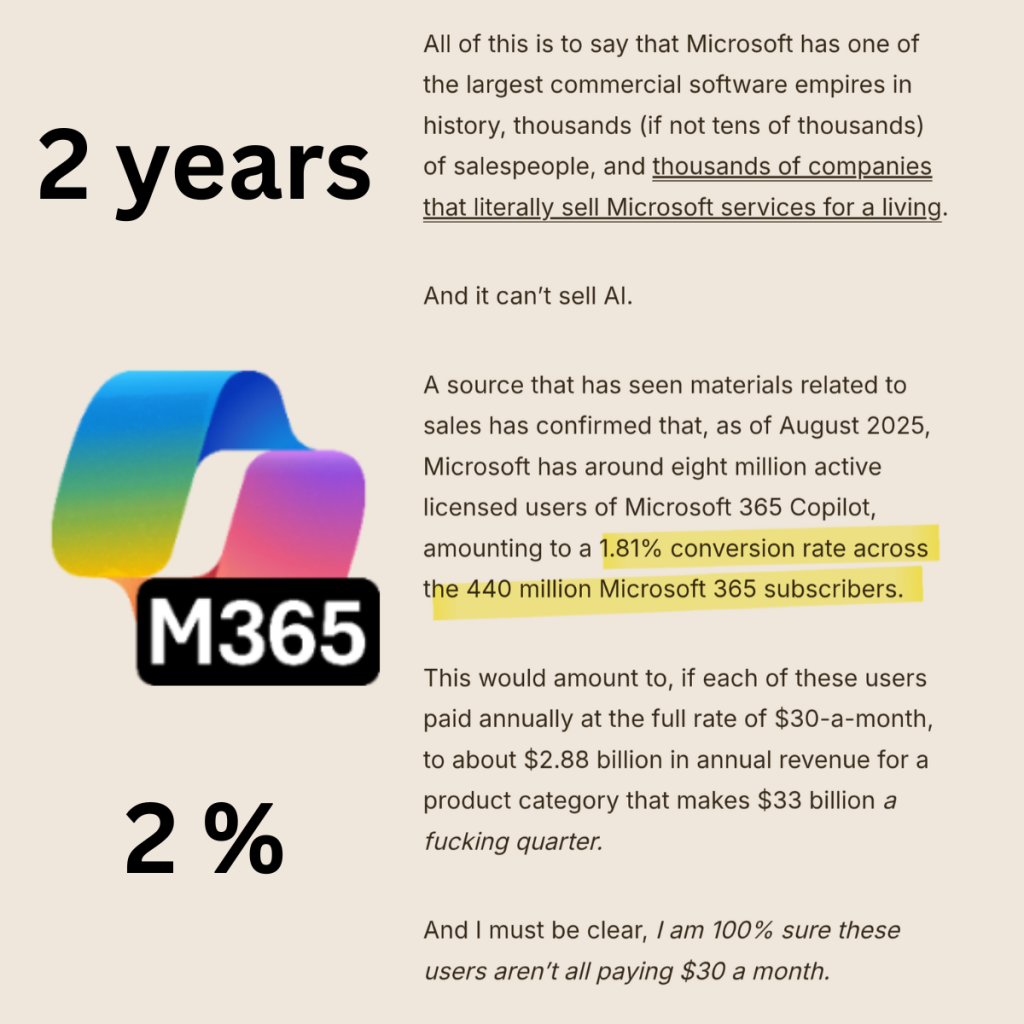Microsoft’s ambitious push to monetize AI in Microsoft 365 started with a simple idea – charge per user for “Copilot” AI features. Initially hailed as a game-changer, the $30-per-user-per-month M365 Copilot license promised to infuse everyday Office apps with GPT-powered smarts. Two years on, however, that model hasn’t lived up to the hype. Adoption of paid Copilot has been underwhelming – reportedly less than 2% of Microsoft 365 users opted in, roughly 8 million out of 440 million customers.
Now Microsoft appears to be pivoting to a new approach dubbed Agent 365, hinting at a major shift in how AI is packaged and sold. This post unpacks the path from per-user licensing to the emergence of Agent 365 – why the original model didn’t scale, what Microsoft tried to salvage it, and how an “agentic” licensing model might fix Microsoft’s business problem (while introducing new budget headaches for customers).
The $30 Copilot: Big Hype, But Little Traction
When Microsoft 365 Copilot was unveiled, it came with a hefty price tag and sky-high expectations. For $30 per user per month, enterprises were told every knowledge worker could have an AI assistant in Word, Excel, Teams, and more. The reality: most organizations balked at deploying Copilot broadly. Uptake has been disappointing – unofficial leaks pegged paying Copilot seats at only ~8 million, a 1.8% conversion rate of the total M365 user base. In other words, the vast majority of Microsoft’s customers did not buy in. This poor adoption despite an unprecedented marketing push could rightfully be described as a commercial failure.

Why did the per-user model stumble? A few key reasons:
- High Cost vs. Unproven Value: At $30 a head, the subscription effectively doubles the cost of an Office 365 E5 license for uncertain benefit. Many organizations didn’t see enough ROI from Copilot’s capabilities to justify that premium.
- Partial Deployment Dilemma: Buying AI for only a subset of users created haves and have-nots. Yet rolling it out company-wide was prohibitively expensive for most. This all-or-nothing dynamic stunted broad adoption.
- Competition & Workarounds: Employees found free or cheap alternatives like ChatGPT on their own. In fact, surveys indicate up to 90% of enterprise users prefer going to ChatGPT, with Copilot trailing far behind newer AI like Anthropic’s Claude and Google’s Gemini. Why pay $30 for Copilot if individuals can use external AI tools?
- Perception and Trust Issues: Microsoft embedded Copilot icons everywhere (even for users without licenses), which some saw as pushing the feature too aggressively. And unlike a human assistant that actively does tasks, Copilot often felt like a fancy autocomplete. Many were not convinced it could deliver truly valuable “assistant” work beyond chatty answers.
Microsoft’s own branding didn’t help. The “Copilot” name was slapped on dozens of products – GitHub Copilot, Security Copilot, Dynamics Copilot, etc. Even CEO Satya Nadella quipped that no one can keep up with the different Copilots anymore. What started as a promising concept became diluted and confusing. Internally, there’s recognition that Copilot has veered uncomfortably close to becoming “Clippy 2.0”, a joke rather than a must-have tool. All of this set the stage for a re-think of the strategy.
Microsoft’s Attempts to Rescue the Copilot Model
Faced with poor uptake, Microsoft didn’t stand still. They’ve tried multiple tactics to make the per-user Copilot model more palatable and valuable:
- Giving Away Chat: Microsoft quietly made the Copilot chat interface available in certain apps for free, muddying the waters on what features require the paid license. For example, Copilot Chat popped up in the M365 homepage and Word/Excel even for unlicensed users. This drove engagement but also sowed confusion – some users now believe “Copilot is free inside M365”. By blurring free vs. paid features, Microsoft undercut its own premium offering’s clarity.
- Bundling More Value: In response to customer feedback, Microsoft started bundling previously separate AI add-ons into the main Copilot license. They collapsed standalone “Copilot for Sales/Service/Finance” subscriptions into the core M365 Copilot license at no extra cost. They also removed paywalls on certain advanced Copilot Studio capabilities for those already paying for Copilot. The idea was to make that $30 fee cover more scenarios out-of-the-box.
- Promotions and Pre-Purchases: To ease concerns about runaway usage costs, Microsoft introduced a Copilot Credit Pre-Purchase Plan (P3), letting companies buy AI consumption credits in bulk (e.g. 300,000 credits) up front. This signals a gradual shift towards usage-based pricing models. However, it’s inherently hard for customers to predict AI usage, especially if Copilot were truly doing work autonomously.
- Reframing the Narrative: Perhaps most telling is Microsoft’s effort to reposition the entire offering. In late 2025, rumors swirled (now essentially confirmed by leaks) that Microsoft plans to rebrand the $30 M365 Copilot product as “M365 Agent”. The functionality would be the same, but the story changes – moving away from the beleaguered Copilot brand and tapping into the industry excitement around “AI agents.”

All these moves point to Microsoft recognizing that the per-seat Copilot approach wasn’t working. Simply put, it hasn’t delivered the revenue or momentum Microsoft hoped for. As a result, the company is gearing up for a bolder pivot – one that not only changes the product positioning, but fundamentally alters the licensing model underlying it.
The Emergence of Agent 365: AI “Agents” to the Rescue
Enter Agent 365, Microsoft’s next evolution of its AI monetization strategy. Details are still emerging (Microsoft is expected to formally announce Agent 365 at the Ignite conference in November 2025), but what we know so far signals a dramatic shift: from licensing human users to licensing AI agents.
Instead of treating AI as a feature add-on for each person, Microsoft is treating AI itself as a first-class digital worker. In the now deleted roadmap item, Microsoft described “a new class of AI agents that operate as independent users within the enterprise workforce.” In practice, this means an organization will deploy AI agents as separate identities – each with its own account, credentials, and role – rather than just enabling a feature on a human user’s account. Microsoft will sell these “agentic users” through a new M365 Agent Store, and admins will be able to approve and instantiate agents much like they assign licenses to employees.
Crucially, each of these agents will require its own Agent 365 (A365) license. Leaked admin documentation indicates “Admins assign the required A365 license at the time of approval. No additional Microsoft 365 or Teams license is required.” In other words, the Agent 365 license is a bundle that gives the AI agent all the access it needs to act like a user – email, Teams, SharePoint, and yes, the Copilot AI capabilities – without piggybacking on a human user’s licensetheregister.com. The agent becomes a fully licensed entity unto itself.
Microsoft quickly deleted the M365 Message Center information about these upcoming features. I did, however, capture the information for the few hours it was public on November 6th, and created this summary video of what was revealed about Agent 365:
From Microsoft’s perspective, this “agentic licensing” could solve several business problems:
- New Unit of Monetization: The agent becomes the unit of value, not the user. This opens the door to selling more licenses than there are humans in your organization. As one licensing expert mused, Microsoft likely finds it “most lucrative when there are more licensable agents than users – e.g. each employee utilizing multiple AI agents.” Under the Copilot model, one human = one license; under Agent 365, one human could employ a fleet of AI helpers (each requiring a license). It’s easy to see the revenue potential if agents catch on.
- Aligning Cost with Usage: If certain tasks or processes generate heavy AI workload, companies can license dedicated agents for those, rather than paying a blanket fee for every single user regardless of whether they use the AI. This could make AI costs somewhat more elastic – heavy users might employ several agents (and pay more), while light users might not use any agents. Microsoft’s CFO Amy Hood has hinted that pure consumption-based billing won’t be the only model for AI – expect hybrid approaches combining subscriptions and usage fees. Agent 365 seems to embody that: a per-agent subscription that likely includes some baseline of AI usage (with overages or credit top-ups if agents work overtime).
- Repackaging Existing Tech as New Value: By all accounts, Agent 365 isn’t introducing radical new AI technology on day one – it’s largely rebranding and repackaging what already exists (Copilot, Power Platform automation, etc.) into the agent framework. But that packaging is key: it fills the gap between today’s rather limited Copilot and the grand vision of autonomous AI “coworkers.” It allows Microsoft to tell a new story (autonomous agents!) and charge for it, without waiting on some future breakthrough. “The Copilot is not enough,” as I put it in my Agent 365 speculations back in August. Agents are a way to re-energize the narrative and make Microsoft’s AI offering sound indispensable for the enterprise.
- Defining “Agent” on Microsoft’s Terms: In the Wild West of generative AI, nobody agrees on what an “AI agent” truly is – which is precisely an opportunity for Microsoft. By creating a product called Agent 365, Microsoft can influence the definition in a way that suits its business. The company’s expertise in crafting software licensing models gives it an edge here. 2025 was decided to be the year of AI agents… it’s critical for MS to leverage its expertise in licensing model design and grab the opportunity to define what an agent is. In effect, if Microsoft can establish that enterprise-grade AI agents = something you buy via Agent 365, it sets the standard (and anchors itself as the provider of that standard).
In short, Agent 365 is Microsoft’s bid to fix the commercial shortcomings of Copilot’s first incarnation. It’s a classic Microsoft move: take a shaky Version 1, “reimagine, rename, and re-license” it, and come back stronger. By reframing Copilot as “agents” – with new capabilities and control – Microsoft can go back to its customers with a fresh value proposition instead of dwelling on the past two years of underwhelming results. Early adopter customers who bought Copilot are being repositioned as pioneers of “enterprise-grade agentic AI” (in Microsoft’s marketing speak) so they can serve as case studies for Agent 365. It’s essentially a do-over, but one that could indeed shake up the status quo if executed right. However, customers need to go in with eyes open, because solving Microsoft’s revenue problem may create new complexities on the customer side.
New Budget Implications for Customers
If Agent 365 is the answer to Microsoft’s AI monetization woes, what does it mean for those paying the bills? In a nutshell, AI costs may shift and even increase in surprising ways. Licensing professionals and procurement teams will need to prepare for a world where deploying AI isn’t a one-and-done add-on, but an ongoing portfolio of “digital workers” to manage financially and operationally.
Some implications to consider:
- Paying for Digital Headcount: Today, you roughly budget AI as $X per user. Tomorrow, you might budget $Y per agent – and the number of agents could multiply beyond your number of employees. For example, if each of 100 customer support reps gets their own AI support agent, that’s 100 extra licenses. If your marketing team employs a market research agent, a social media agent, and an analysis agent, a single marketer might rely on 3 AI agents. Microsoft is betting that companies will deploy many agents once they see the utility. From a budget standpoint, this is akin to paying for additional “virtual FTEs.” Organizations will need to forecast how many agents they truly need and monitor that “digital labor sprawl” so it doesn’t run away. Microsoft will be happy to sell you as many as you’ll take.
- Unpredictable Consumption Costs: While an Agent 365 license will cover the baseline abilities of an agent, these agents will consume cloud resources (AI models, API calls) as they operate. Microsoft’s recent Copilot credit packs hint that usage-based billing will factor in. The tricky part: if agents are semi-autonomous, running tasks in the background, how do you predict or cap their usage? Licensing experts are already warning that it’s much harder to forecast costs if AI agents are doing things on their own. Customers may face volatile monthly charges if an agent suddenly gets popular or if you spin up new agents mid-year. This makes the business case for each agent a bit harder – you’ll need to monitor utilization and perhaps set governance on how often agents can run high-cost operations.
- License Management Churn: Today’s user licenses are usually stable – tied to employees who (mostly) stick around. AI agents, however, might be created and decommissioned more dynamically. This raises questions: If an agent is retired, does its A365 license automatically free up? Or will companies end up with a shelf stock of unused agent licenses “just in case,” wasted on annual contracts? One licensing specialist noted that even with human users, ~15% of Office 365 licenses go under-utilized due to churn and over-provisioning. With agents, that inefficiency could worsen if not tightly managed. Imagine buying a dozen agent licenses for a project, then the project ends – do you have a process to promptly re-harvest or cancel those licenses? Without discipline, organizations could overspend on AI capacity they aren’t using.
- Stacking of Third-Party Fees: Microsoft’s Agent Store will likely feature third-party AI agents (the leaked screenshots even name-checked a ServiceNow support agent). Licensing those may involve additional subscriptions or fees to the ISV providing the agent. For instance, deploying a ServiceNow-authored agent might require a ServiceNow license or transaction fee on top of Microsoft’s A365 license. The economics of who gets paid for an agent’s “knowledge” or domain expertise is still unclear. But customers should be aware that an agent that hooks into an external system or vendor could carry its own licensing terms. The Agent 365 model introduces an app store dynamic to AI – potentially great for flexibility, but be ready to read the fine print (and budget for it).
- Budgeting for Governance & Compliance: Ironically, adopting more AI may necessitate increasing spend on management tools and advisory services. As we’ll discuss in the next post, governing a host of AI agents will be no small feat. Companies might need to invest in new monitoring software, auditing capabilities, or even premium Entra ID features to manage these non-human identities at scale. All of that can add to the total cost of ownership of AI. Furthermore, if AI agents start taking on significant business processes, organizations might divert budget from other areas (or from human headcount) into AI enablement and oversight. The AI promise is productivity, but any cost savings won’t materialize unless the deployment is right-sized and well-governed.
To be clear, Agent 365 isn’t a scheme to rip off customers – it actually could provide more flexible value than the one-size-fits-all Copilot licensing. But it’s also not a money-saving play. It’s designed to help Microsoft capture more of the value AI creates. Microsoft’s own documentation reminds us that eventually AI services need to stop being a “non-profit adventure” and show real revenue. Agent 365 is explicitly about finding “a new commercial model beyond per-seat SaaS licensing”, so customers should enter the era of AI agents with a healthy skepticism toward rosy ROI promises.
The Bottom Line
The shift from per-user Copilot to Agent 365 marks a new chapter in Microsoft’s AI journey – one aimed at solving the scale and revenue limitations of the initial approach. Per-user licensing didn’t scale because it was expensive, inflexible, and frankly not compelling enough in its first form. “Agentic” licensing is Microsoft’s answer: change the game by turning AI into individual workers you license separately. This could indeed unlock more powerful AI use cases (and a more sustainable business model for Microsoft), but it will also create new challenges for customers in budgeting, license management, and oversight.
In my next post, I’ll dive into exactly what Agent 365 introduces – from the concept of AI agents as Entra ID identities to the governance controls you’ll need on day one. If you’re feeling confused or skeptical about Microsoft’s direction here, you’re not alone. The key is to get informed early so you can adapt your licensing strategy. After all, the era of AI “coworkers” is coming fast, and it’s likely to rewrite both tech playbooks and budget plans in the year ahead.



